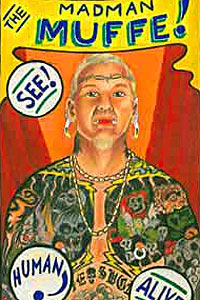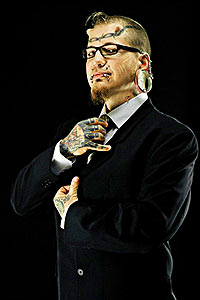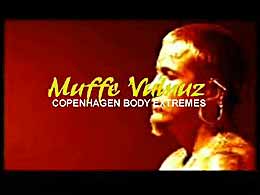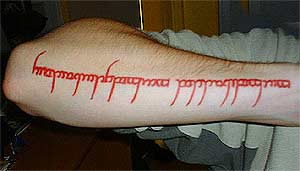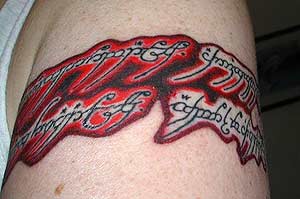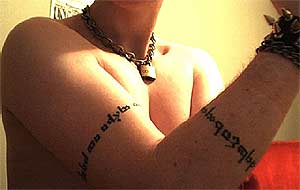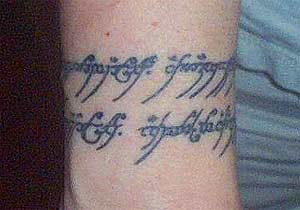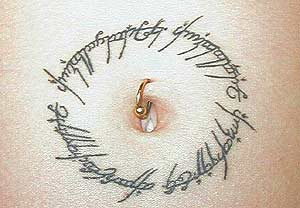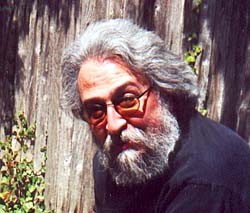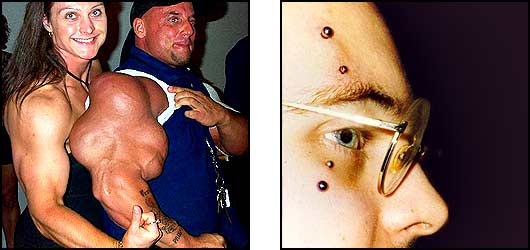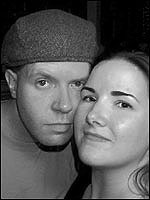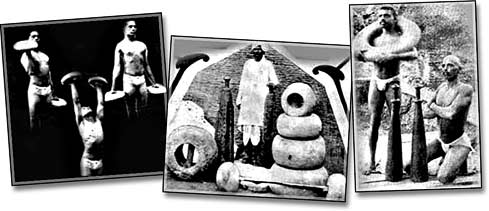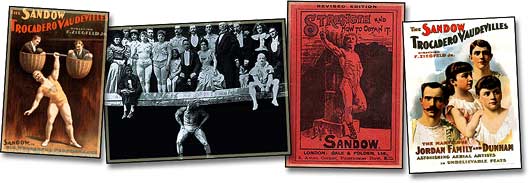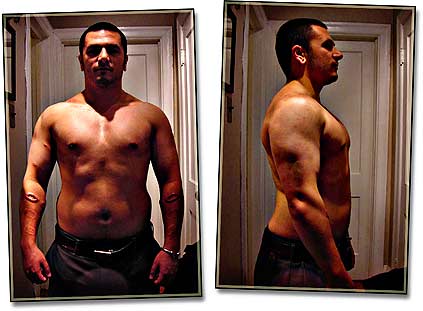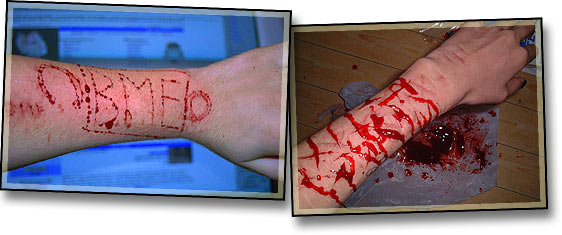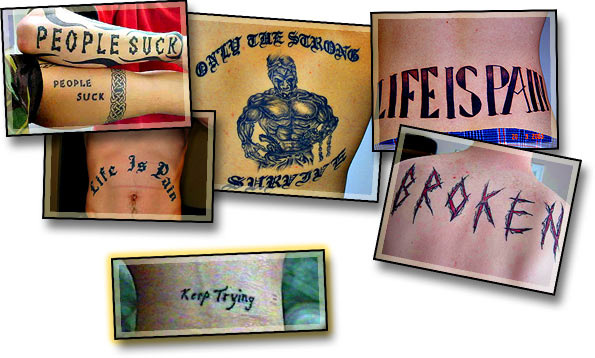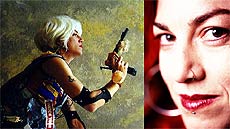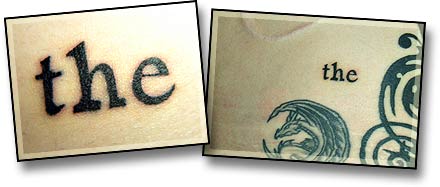On my first day of work at a stereotypical Wall Street law firm, four other lawyers took me for a fancy lunch to welcome me into the fold. All of us in dark suits and pasty white faces politely conversed about acceptable topics, all the while making sure we were using the right fork, until the moment when a man with neon hair, neck tattoos, and multiple facial piercings flashed before the window next to where we sat. The forks dropped. The man outside walked on. But his presence still lingered at our table.
“I don’t understand these freaks with all the tattoos and piercings,” started one at our table, and the discussion spiraled onwards towards burning the modified at the stake. Fortunately for me, my piercings and tattoos at the time were easily covered, otherwise I would’ve gotten singed.
…Or fired.
“A person can be fired because the company doesn’t like your shoes,” explains Robert D. Lipman, who manages the New York employment firm Lipman & Plesur, LLP, and is President of Interactive Employment Training, Inc.. I called Lipman to ask whether a person fired solely for having visible tattoos or piercings has any recourse under United States law. “We get a lot of calls like this,” he said. “People say ‘This is America. We should be able to do what we want.’ But I tell them that once you walk into a private employers workplace, your rights are limited.”
Limited, but not null.
Title VII of the US Civil Rights Act of 1964 says that a private company with more than fifteen employees cannot discriminate on the basis of religion, sex, race, color, or national origin. So company decisions to hire, fire, promote, shell out benefits or the key to the Executive Washroom must not be based on these “protected classifications.” To do so is illegal. Title VII is not the only law that protects Americans from job discrimination. Many state laws have extended protection against discrimination on the basis of sexual orientation, transgenderism, and even obesity. There’s also the federal Americans with Disabilities Act, Equal Pay Act, Age Discrimination in Employment Act, Immigration Reform and Control Act, Pregnancy Discrimination Act, and the National Labor Relations Act.
Despite all these Acts, the curtain falls for those judged on their body modifications, no matter how good the performance. That is, unless you can make a claim under one of these classifications.
RELIGIOUS DISCRIMINATION

While employees generally have more success claiming that dress codes infringe upon religious beliefs, for the tattooed and pierced, success is unlikely.
But isn’t body modification a choice like religion?
“Absolutely, yes. But the Constitution specifically guarantees religious protection,” says California and New York licensed attorney John Thomure, who has represented pro-bono petitioners before the US Supreme Court on constitutional protection claims, as well as having contributed to amicus briefs challenging South Carolina’s ban on tattooing. Heavily tattooed himself, Thomure says:
“Although we might grant great spiritual significance to our own body mods, my sense is a court would cast a very skeptical eye on it as a religious practice. And since outside of perhaps indigenous cultures [...] there is no history or antecedents for the “religion,” it would certainly look as though the creation of the body-mod religion was for the purpose in part of creating legal claims under a freedom of religion argument.”
Case in point: The Church of Body Modification [uscobm.com]. The Church states on its web site that its purpose is “for our modified society to harmoniously return to its spiritual roots that have been forgotten.” It adds that “we are not here to offer spirituality to you so much as we are here because of the spirituality that is already in all of us; often expressed through what we do to our bodies.”
This may not cut it as “a bonafide church.” Lipman mentions a California 9th Circuit Court of Appeals case where a vegan filed a discrimination suit under religious classification. The Court rejected the veganism as a religion claim, holding that vegan ethics do not constitute a religious creed because (among others) it is not a comprehensive belief system that addresses “fundamental and ultimate questions having to do with deep and imponderable matters.” Moreover, it noted that some people were vegan for health and not spiritual reasons.
It is very clear that the Church of Body Modification does not offer an answer to that ultimate question: “Why are we here?” And it does state on its site that many people choose to modify their bodies for non-spiritual reasons. Nevertheless, that did not stop one 27-year old woman from filing suit against Costco claiming that, as a member of the Church of Body Modification, her eyebrow piercing was an essential part of her faith. The case is still pending [questions forwarded to her went unanswered], and while unlikely, if it succeeds it could set major precedent in employment law.
Don’t get your hopes up. As Thomure points out, “Think of Mormons […] their practice of polyamory has not been given protection because of a conflict with a larger public policy.”
Public policy is key here because even if the Church of Body Modification could be deemed a bonafide religion, is it reasonable to ask a company like Costco to potentially lose customers who are put off by visible mods, especially more extreme ones? Jewish yarmulkes, beards, and religious garbs are acceptable. Can we claim full-body lizard scales in the same category? And while performer and PhD candidate Erik “The Lizardman” Sprague is probably smarter than all of us, should Costco be forced to have him ring up bulk items for Brooklyn grandmothers (assuming that’s a dream of Erik’s)?
I say no, unless lizard scale tattoos are allowed on female employees but not male, which brings us to…
SEX DISCRIMINATION

If an employer’s dress code significantly differentiates between men and women, without being based on social norms, or poses a greater burden on women, then it can be deemed discriminatory. So, for example, a dress code that allows earrings for women but not men could be considered discriminatory.
Imagine a case where a company allows its male employees to sport visible tattoos, but, after reading in the Philadelphia Daily News that tattooed women are sluts, the employer decides that it’s best for public relations that female workers remain pure and unblemished: To that, one can hear a resounding “Sue their ass!”
Keep in mind that the US courts have often held that anti-discrimination laws are not intended to hinder employers who set reasonable appearance standards fitting for their business. In 1998, the 11th Circuit Court of Appeals in Harper v. Blockbuster Entertainment upheld Blockbuster’s dress code that mandated male employees to cut their long hair, but not female employees.
Thus, even if there are different appearance standards for men and women relating to body mods, it’s still not an easy case to make out.
NATIONAL ORIGIN DISCRIMINATION
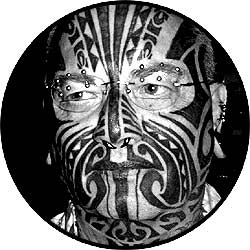
Employers cannot enact a dress code that treats certain employees unfairly because of their national origin unless it would result in undue hardship for the company. This national origin classification covers ancestry, language, accent, and culture, among others. So, for example, a Maori with a moko tattoo could have a claim under this provision as these facial tattoos are based on genealogy and tribal affiliations. Or an East Asian woman could fight to keep in her nose stud at work, claiming the cultural significance of facial adornment, such as in marriage ceremonies.
As a Greek-American, where my ancestors shunned tattooing except to mark the foreheads of criminals, it is improbable that I would fall under the national origin exception. In fact, it is my conservative Greek father who first voiced the claim that I must be crazy for having all my tattoos, which brings me to…
DISABILITY DISCRIMINATION
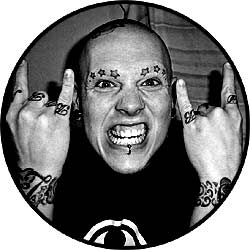
Tattoos as a disability? Is my ink a manifestation of some mental illness? Is it body dysmorphia? Narcissism? Was I not properly toilet trained?
It’s an unsettling argument with possible disturbing consequences.
Thomure agrees. He says that while the idea of body modification as a disability leaves a sour taste in his mouth, he adds that the claim “is not so far fetched.” He tells me to step back and ask “What do people tell you when you ask them ‘Why did you get heavily tattooed?’ Try drawing the real reasons out of people. Most will only answer superficially — ‘they’re pretty,’ ‘I like how I look’ — and hide the real reason.” In speaking with other heavily tattooed people he says that the motivations that are frequently mentioned are:
- It’s empowering and liberating — reclaiming of the body.
- Manifesting externally or physically strong sexual fetish in tattoos or piercing.
- A general sense that one was compelled to get so tattooed to make oneself complete.
It’s that compulsion that could very well be defined as an illness. However, according to Lipman, it’s probably not enough to get you covered under disability protection. Lipman says, “A disability has to impair a major life activity. Does having a tattoo stop you from eating or sleeping?”
No. But other body mods do — self-amputation, for one more extreme example. I’m not suggesting that those who practice body nullification are mentally ill. Hell, “my best friends are [self-amputees],” but it’s not my opinion that counts, but the State’s.
Yet another modified lawyer (yes, there are many of us) and tattooist, Devon, weighed in on the disability issue saying be careful what you sue for when discussing disability protection:
“If I choose to lop off a body part in the name of modification, should I then be entitled to ADA protection? Should I now be able to collect Social Security based on my ‘disability’? To me, the answer to that is a resounding “NO”!
You start to hit governments or corporations in the wallet based on your modifications, and just see how free you are to get modified in the future.”
It’s a strong point. The backlash for filing all these body modification discrimination claims may be the banning of the modifications themselves, as in South Carolina and Oklahoma. Or, even more extreme, involuntary hospitalization.
BRINGING AN ACTION
Still, if you feel strongly that you’ve been wrongly discriminated against for your body mods, you may file a charge with your local Equal Employment Opportunity Commission [EEOC.GOV] office, which may be found online or by calling 1-800-669-4000. An EEOC charge must be filed within 180 days of the date of the disputed conduct.
Outside of the EEOC, a claim for breach of contract can be filed for those who have employment contracts, such as union workers or some executives. According to Lipman, there must be “just cause” to fire someone under an employment contract, unlike “at will” employment — Lipman says that most Americans fall under “at will” employment. He does not believe that a tattoo or piercing constitutes “just cause.”
Lipman also points out that government employees have greater protection than private employees because they not only fall under all those anti-discrimination acts, but they have constitutional protections as well. So, hypothetically, a government employee fired for having tattoos may have a free speech claim. Although I do have a hard time envisioning Condoleeza Rice with a moko testifying on behalf of her boss — the irony of it makes me snicker.
However, employment discrimination is no laughing matter, and legal action should be considered very carefully.
Also ask yourself, is discrimination so bad?
If I was fired from that law firm on my first day, it would have saved me over two years of suffering in an atmosphere that was not right for me. But something good did come out of it: After covering my body mods for a while and proving myself as a competent legal thinker, I eventually revealed that I indeed was “a tattooed and pierced freak.” I was not fired. In fact, just before I came to my own decision to leave the firm, two out of the four lawyers at that first lunch asked if I would let them accompany me when I got my next tattoo. I did and it changed their minds completely.
While it did not change my mind to stop practicing law, I still like to fantasize about opening my own firm to serve the body modification community and discriminate with abandon: The Non-Modified Need Not Apply.
In addition to the people mentioned in this article, I would like to especially thank Rebekah [iam:rebekah] for her invaluable help in case law research, ServMe [iam:ServMe] for his editing prowess, as well as the many other wonderful people of BME who raised important issues in the forums that helped shape this piece. I’d also like to thank Dan [calypsotattoo.com] for making me beautifully less employable. – Marisa Kakoulas
This article is not intended as legal advice. It is intended for only general information purposes. This article does not create any attorney-client relationship.

Marisa Kakoulas is a New York lawyer, writer, and muse of Daniel DiMattia of Calypso Tattoo, living in Liege, Belgium. She works undercover — or just covered up — as a corporate consultant: proof that tattoos and suits are not mutually exclusive. Her book “Tattoo Law”, an overview of US laws affecting the body modification community, is under way. IAM members can visit Marisa at iam:FREE.
Copyright © 2004 Marisa Kakoulas. Online presentation copyright © 2004 BMEzine.com LLC. Requests to republish must be confirmed in writing. For bibliographical purposes this article was first published online April 5th, 2004 by BMEzine.com LLC in Toronto, Ontario, Canada.

